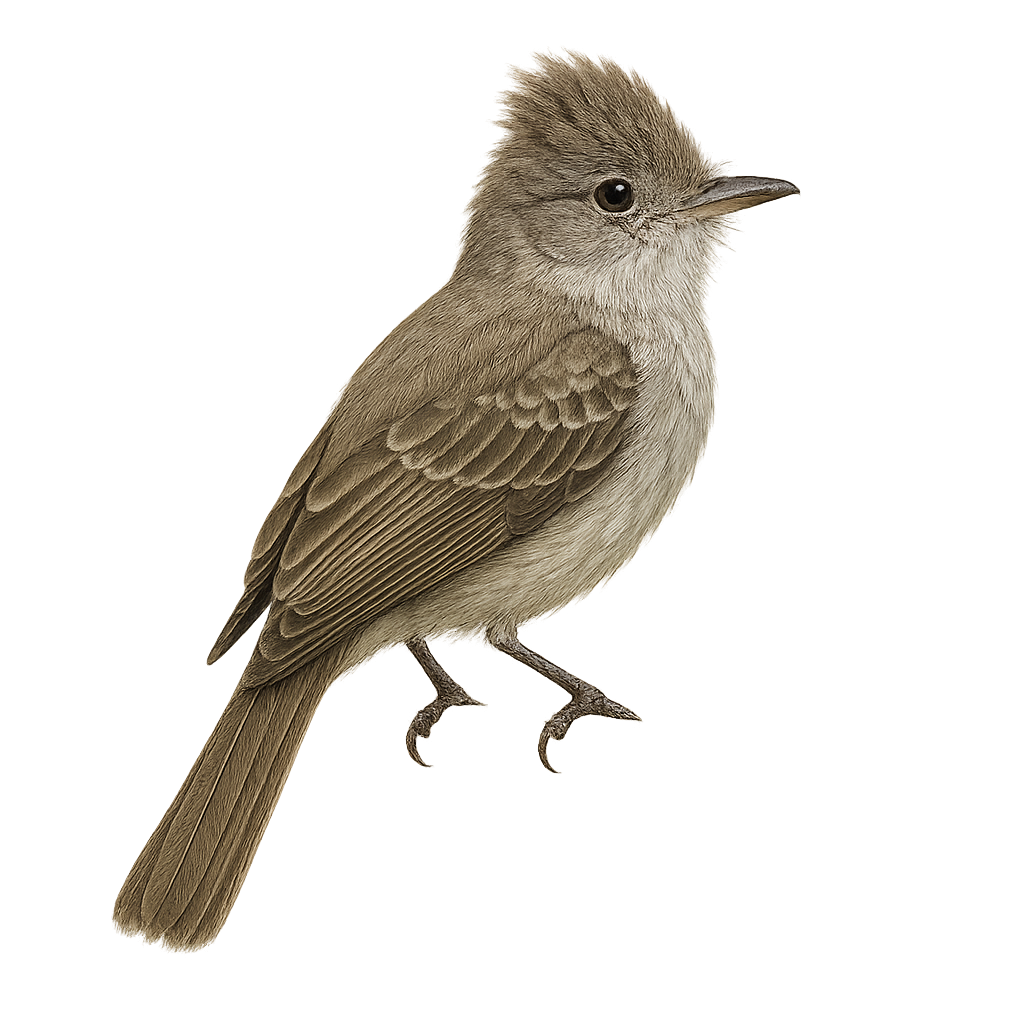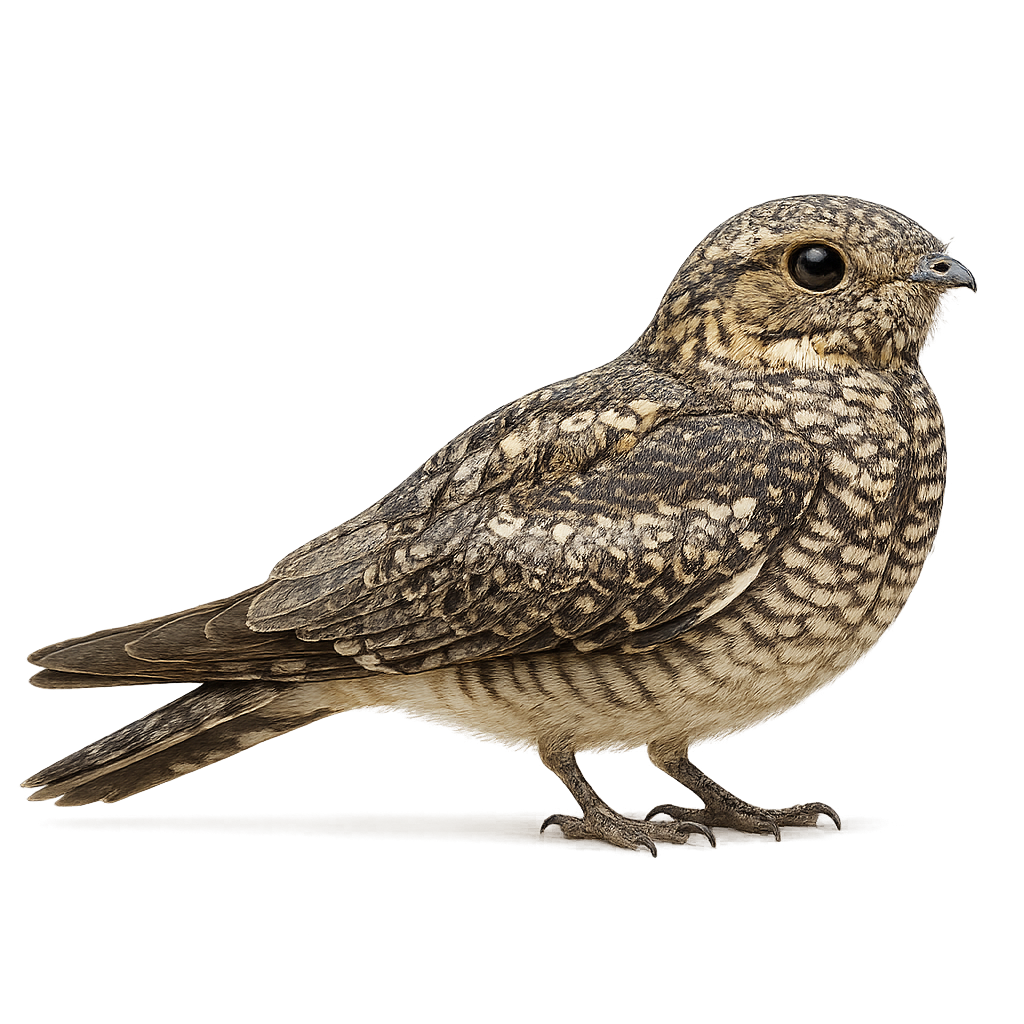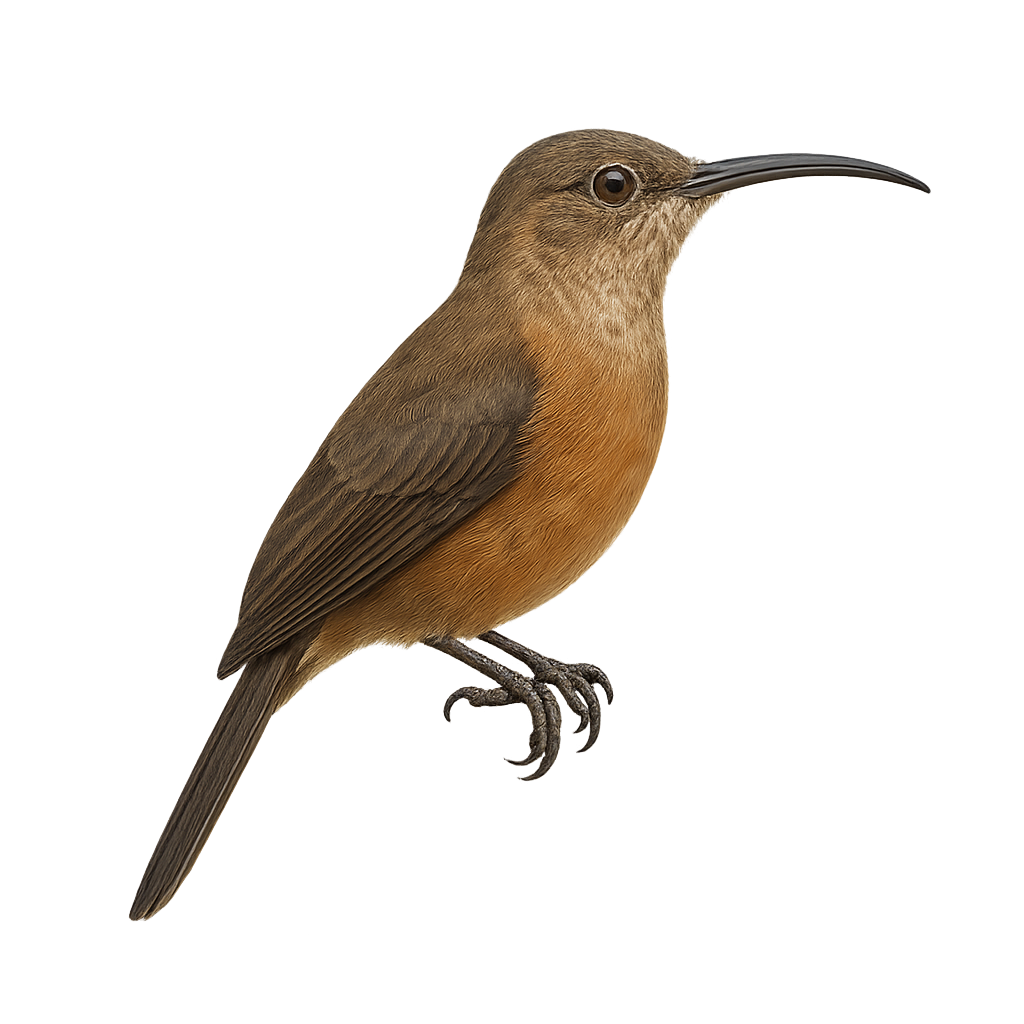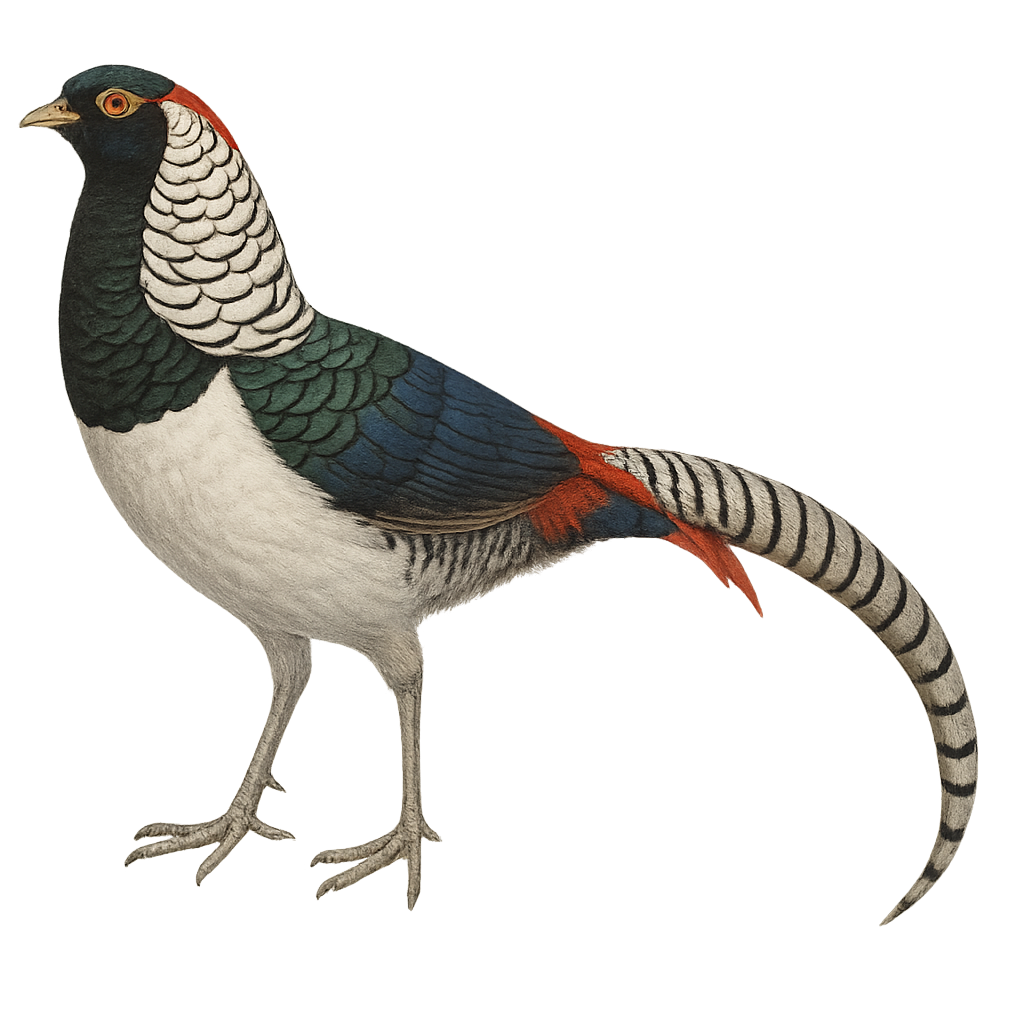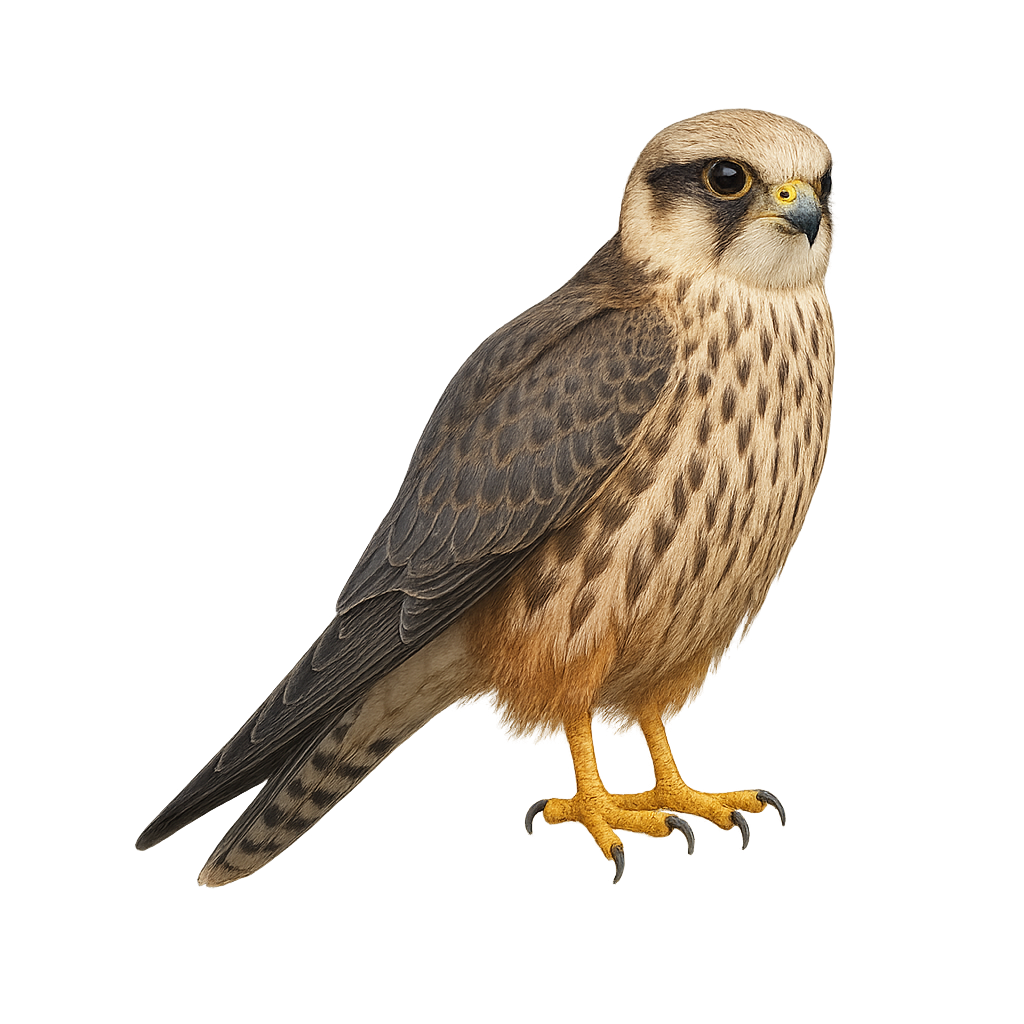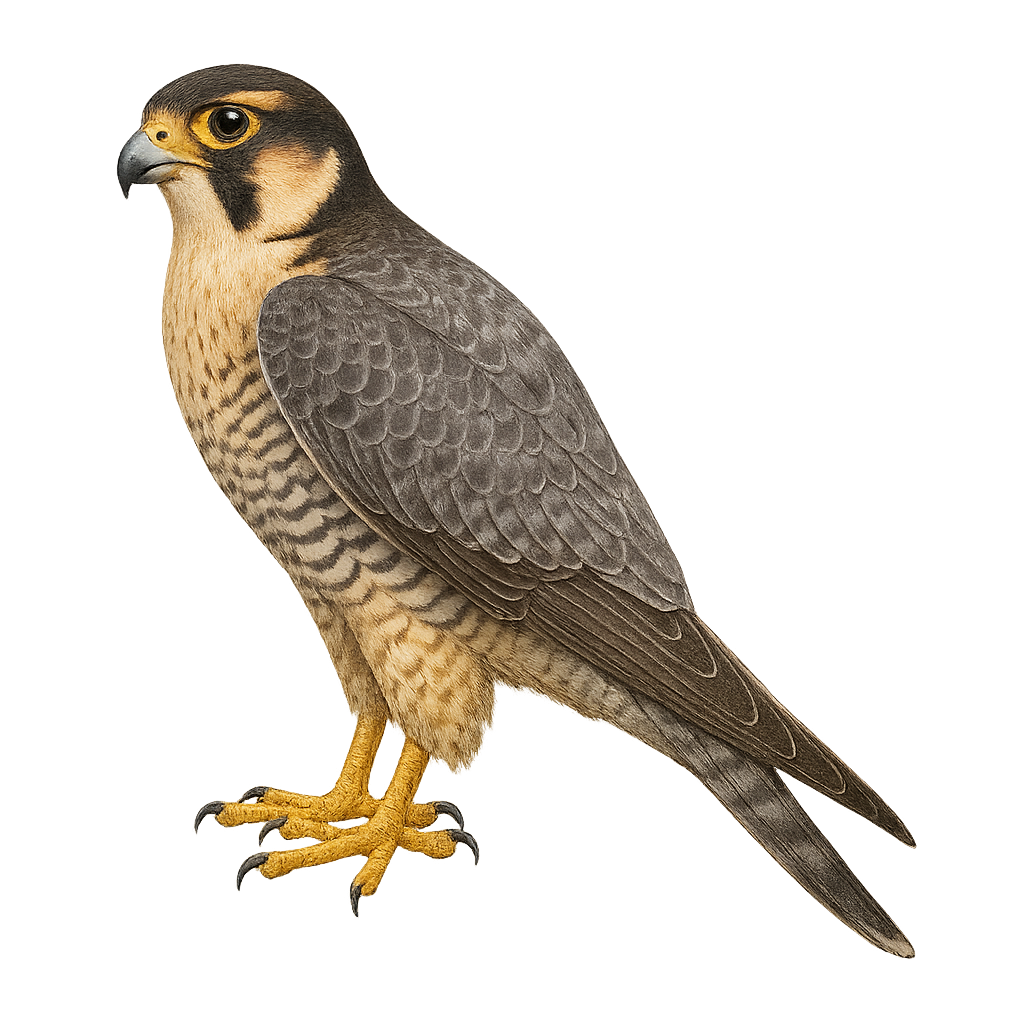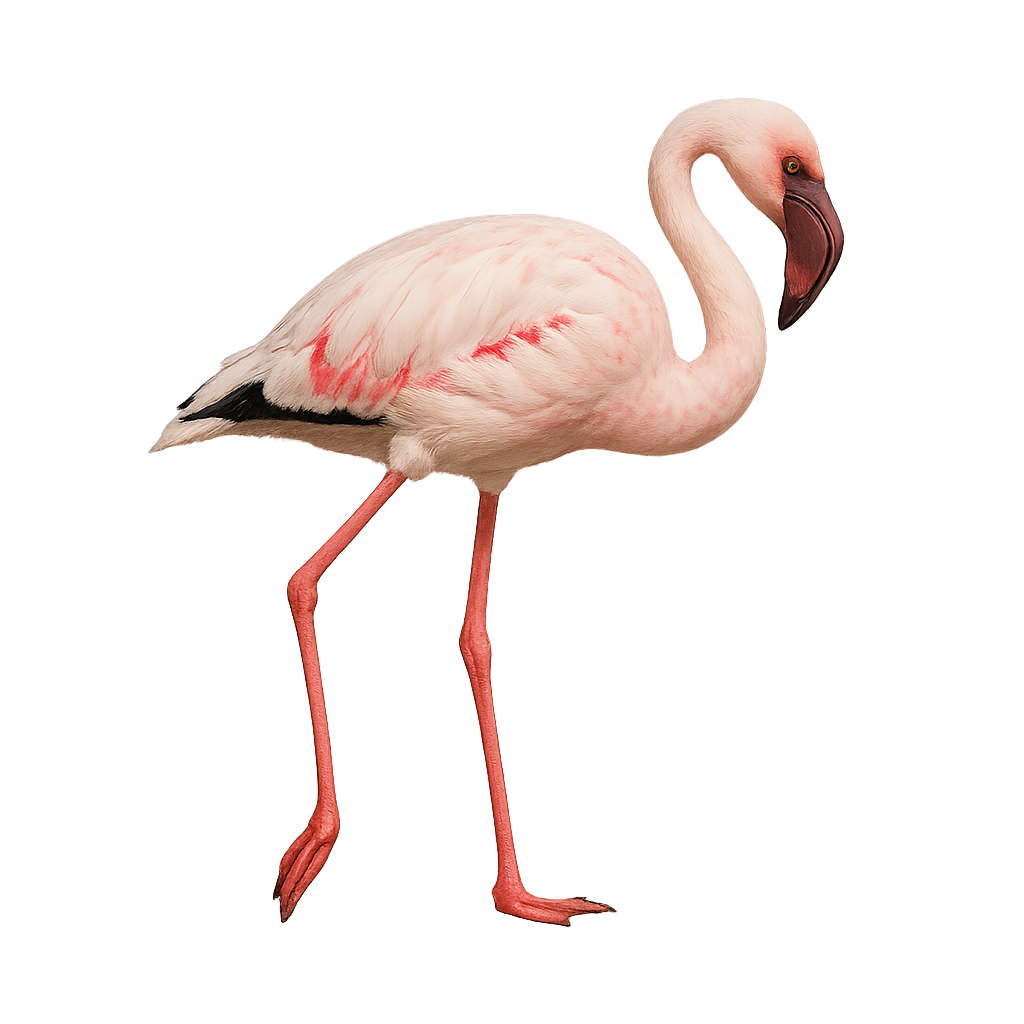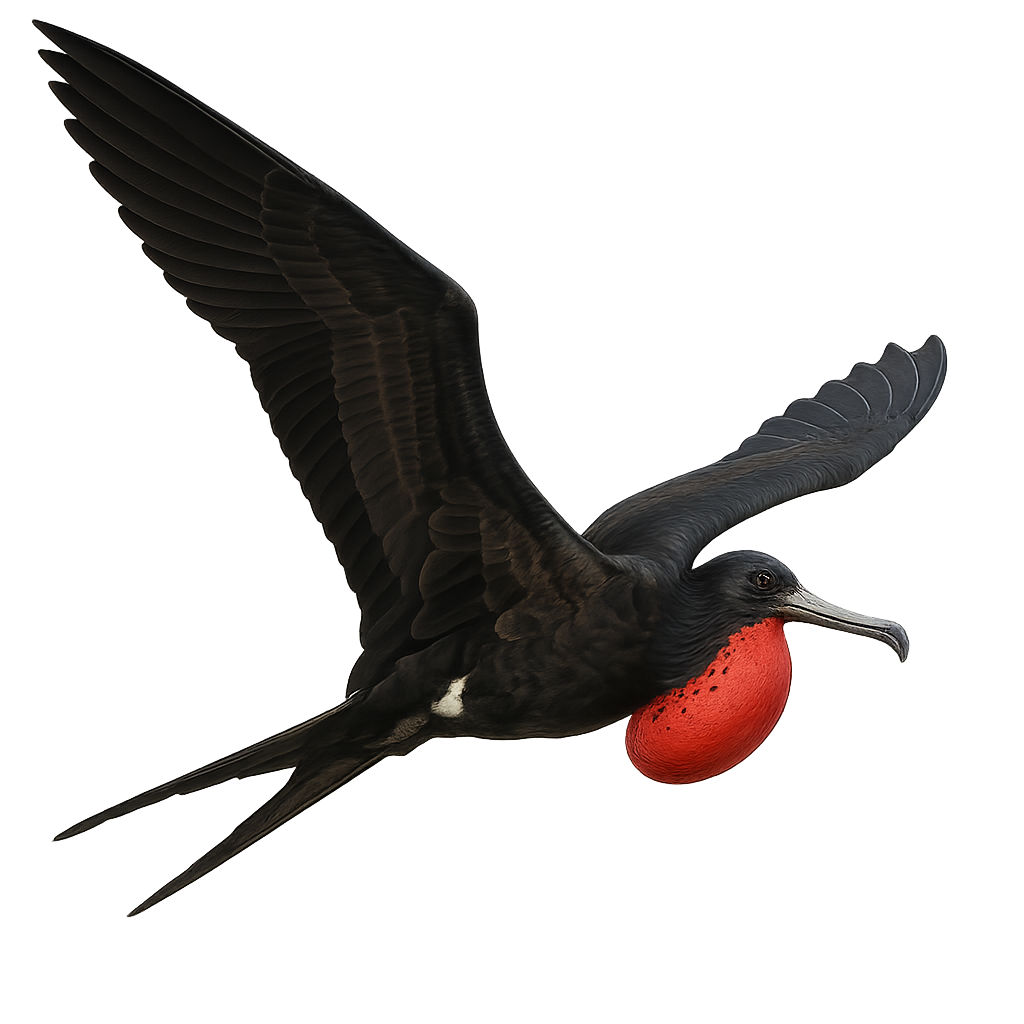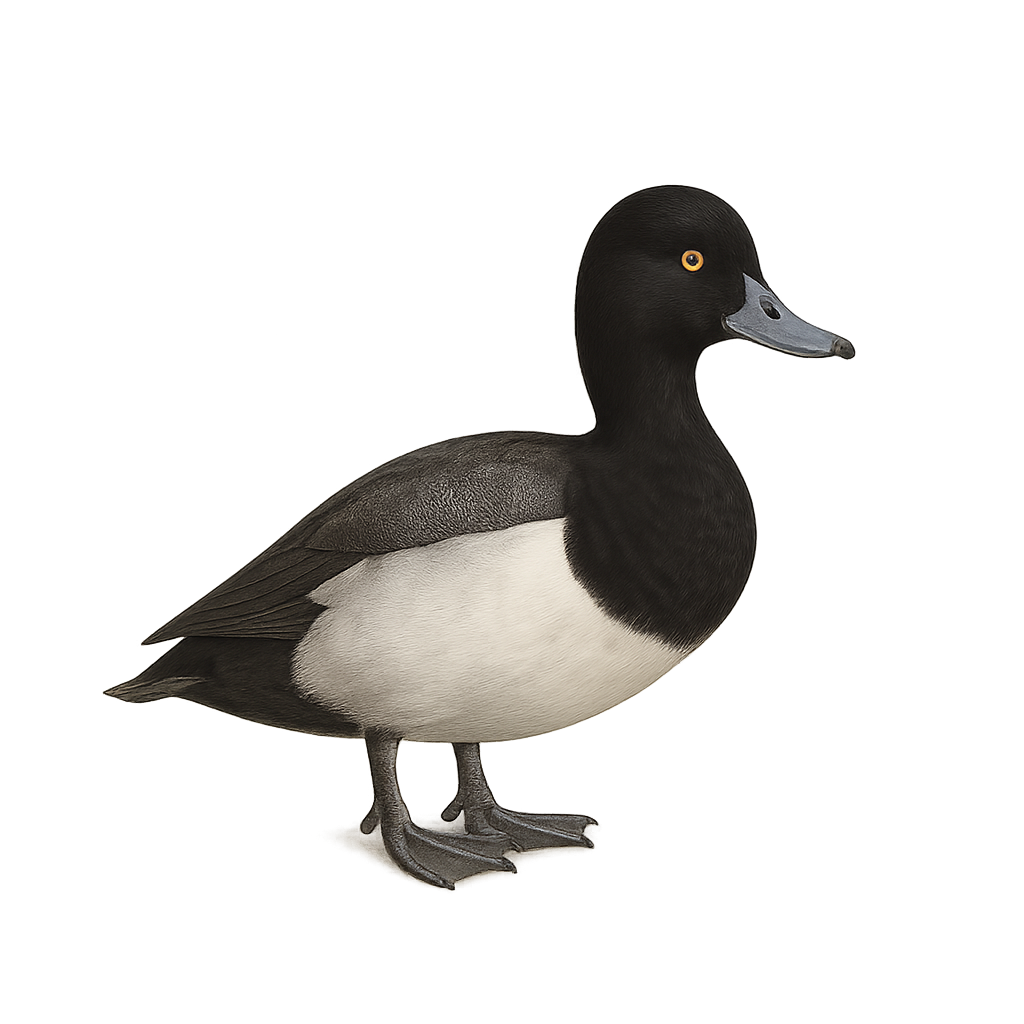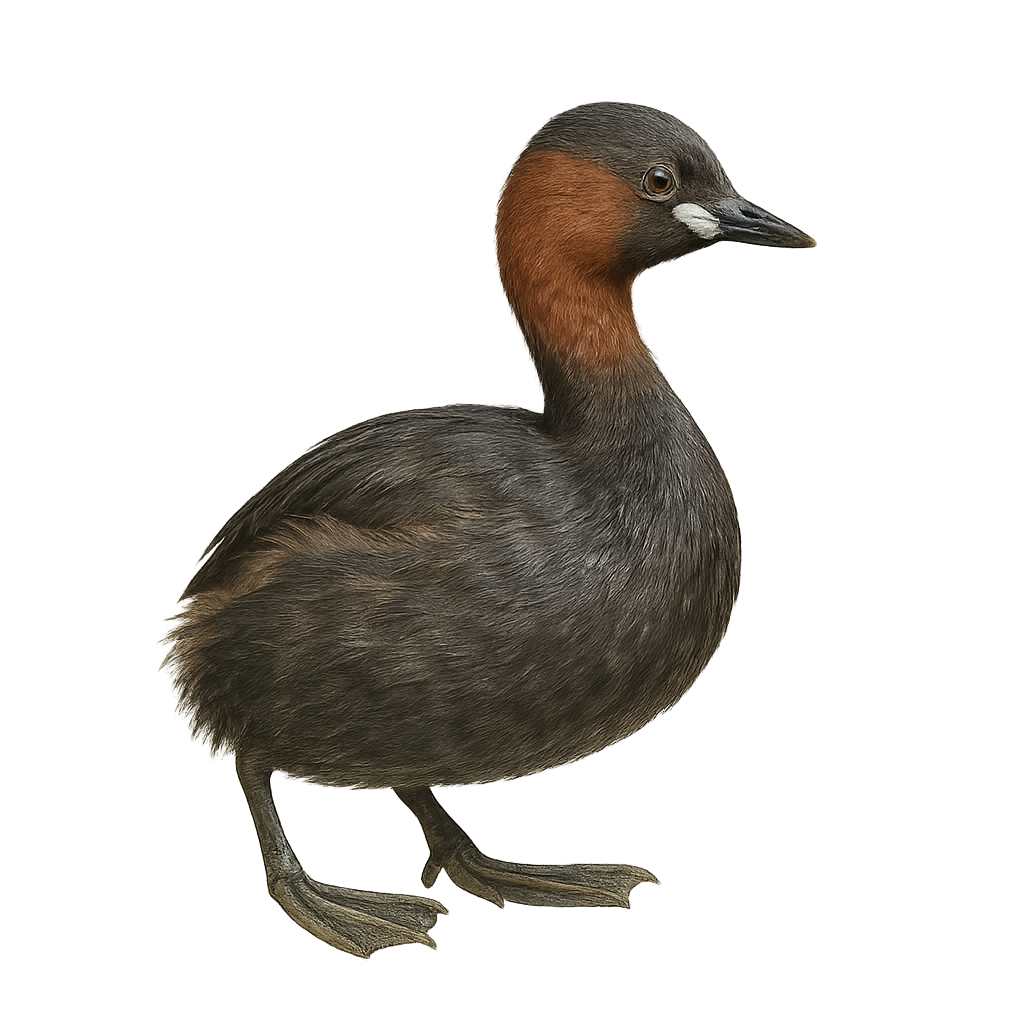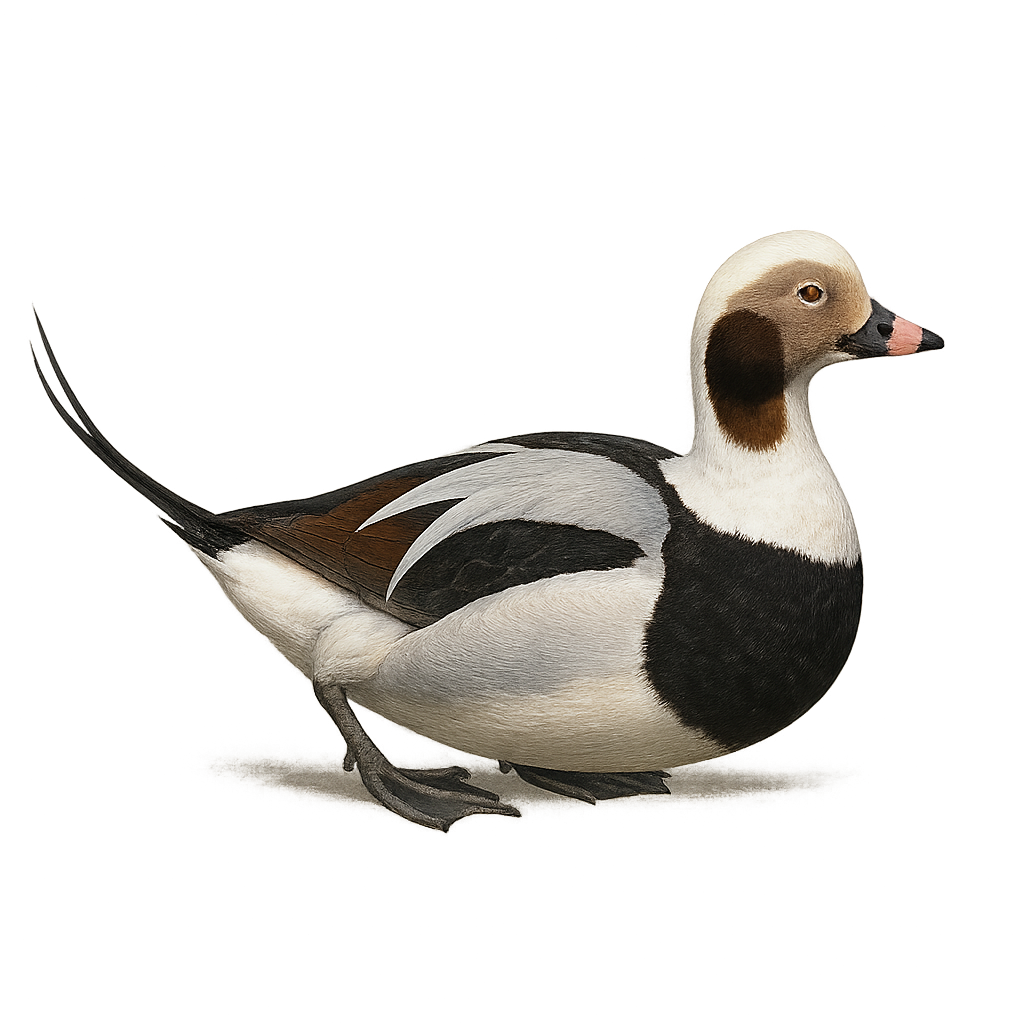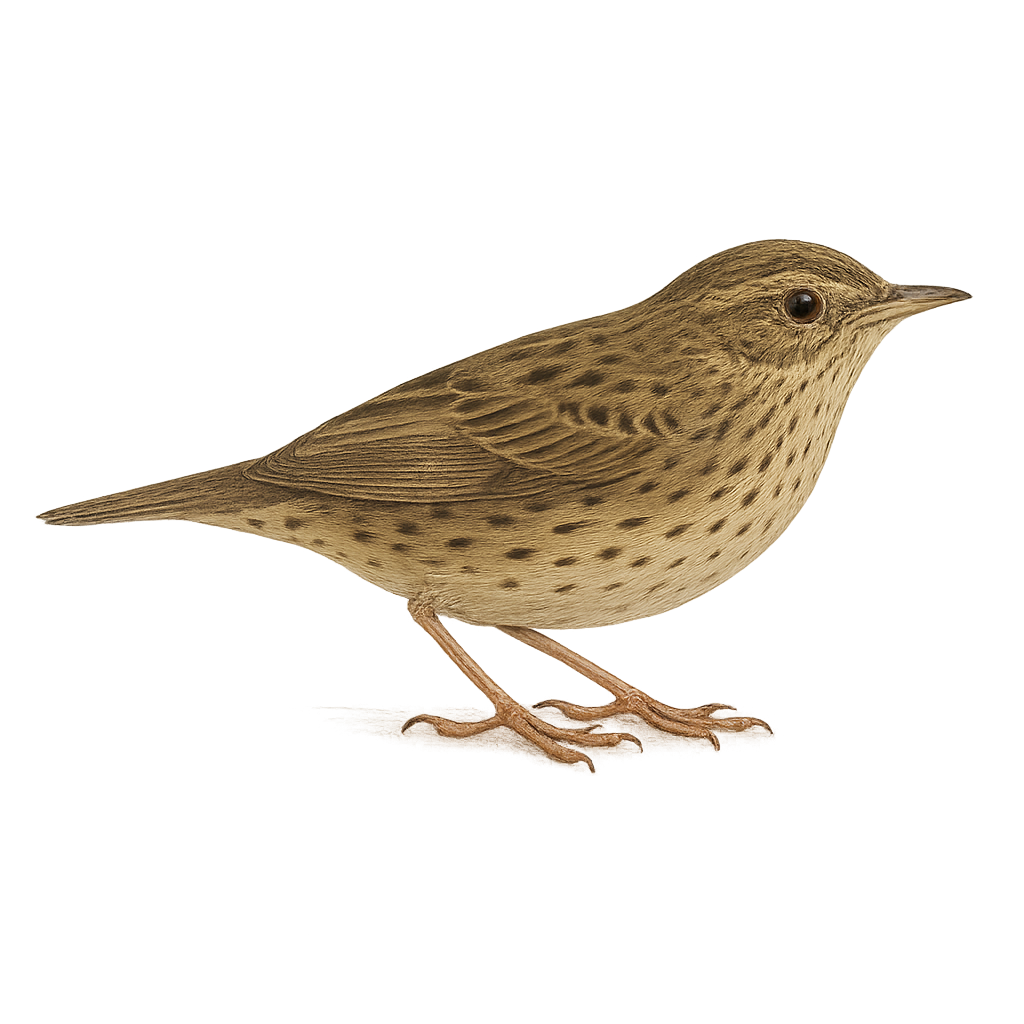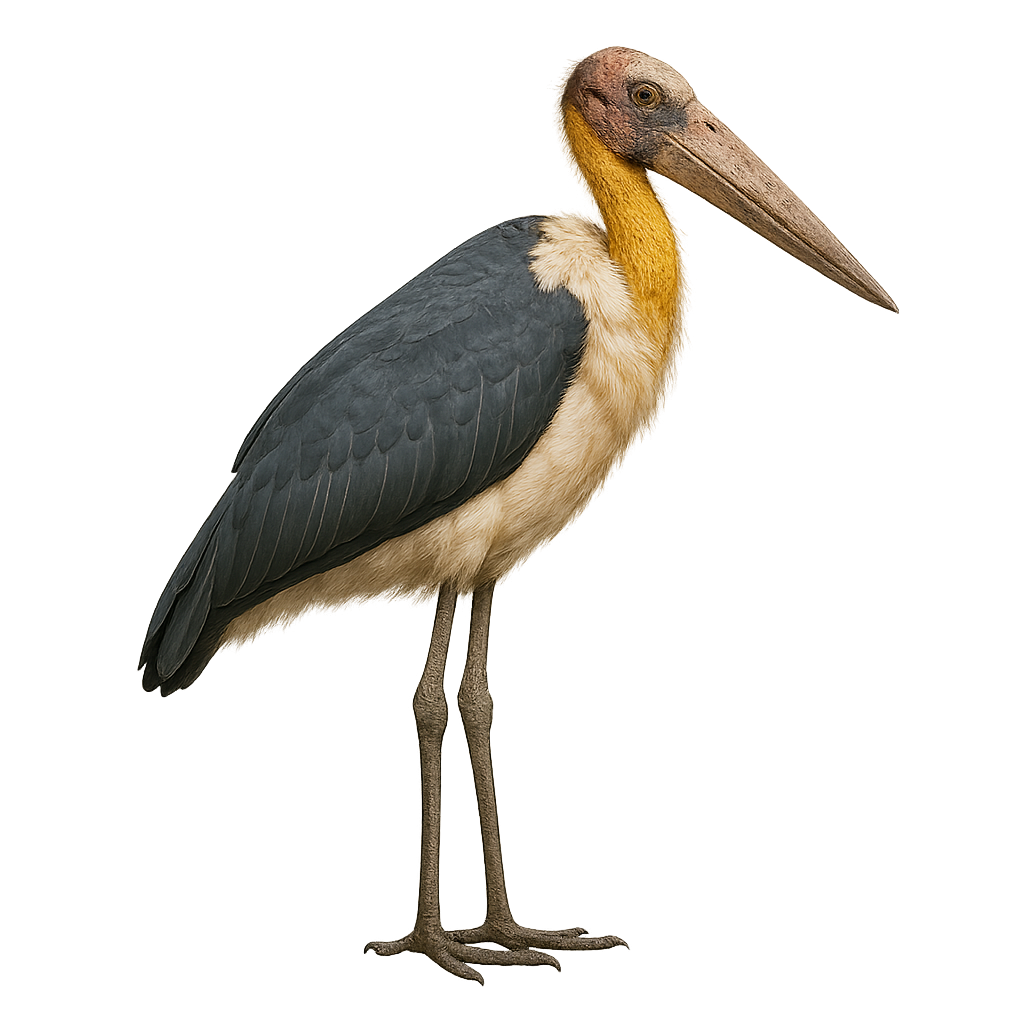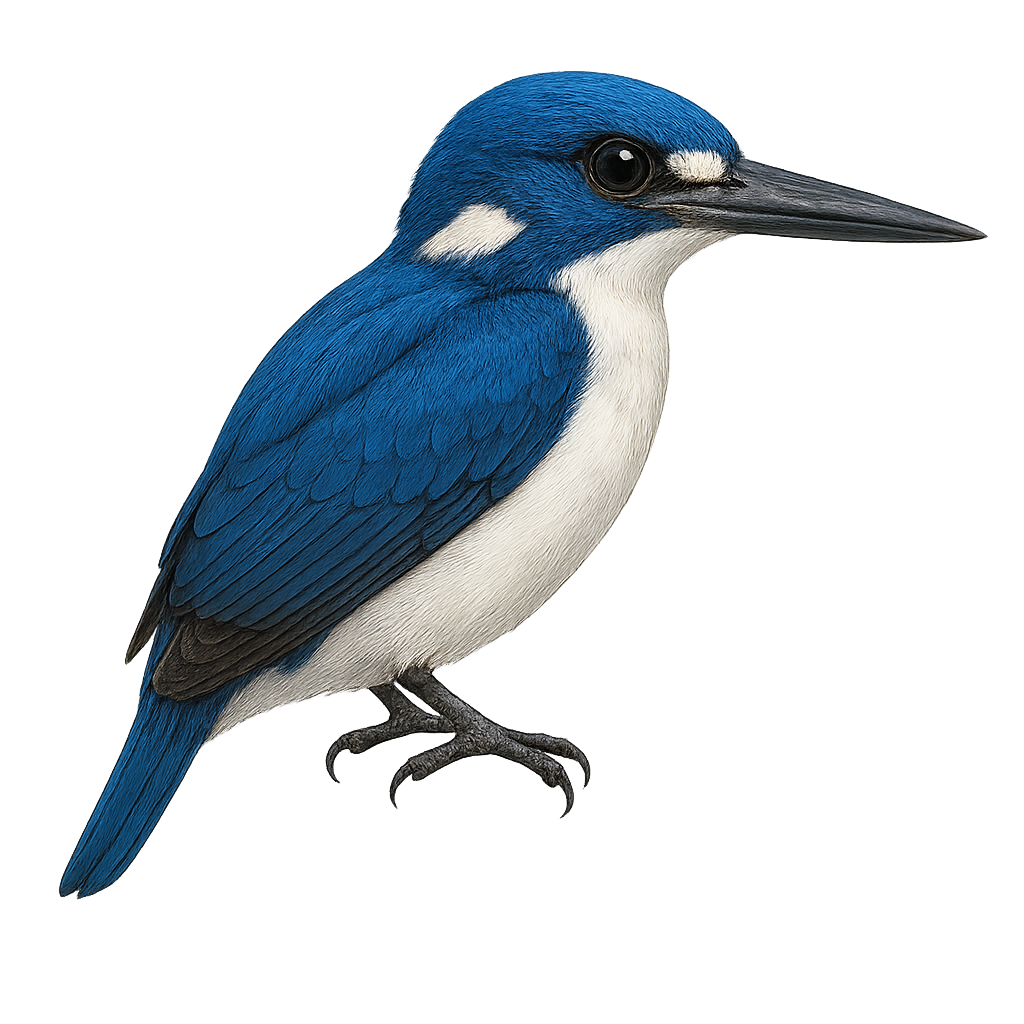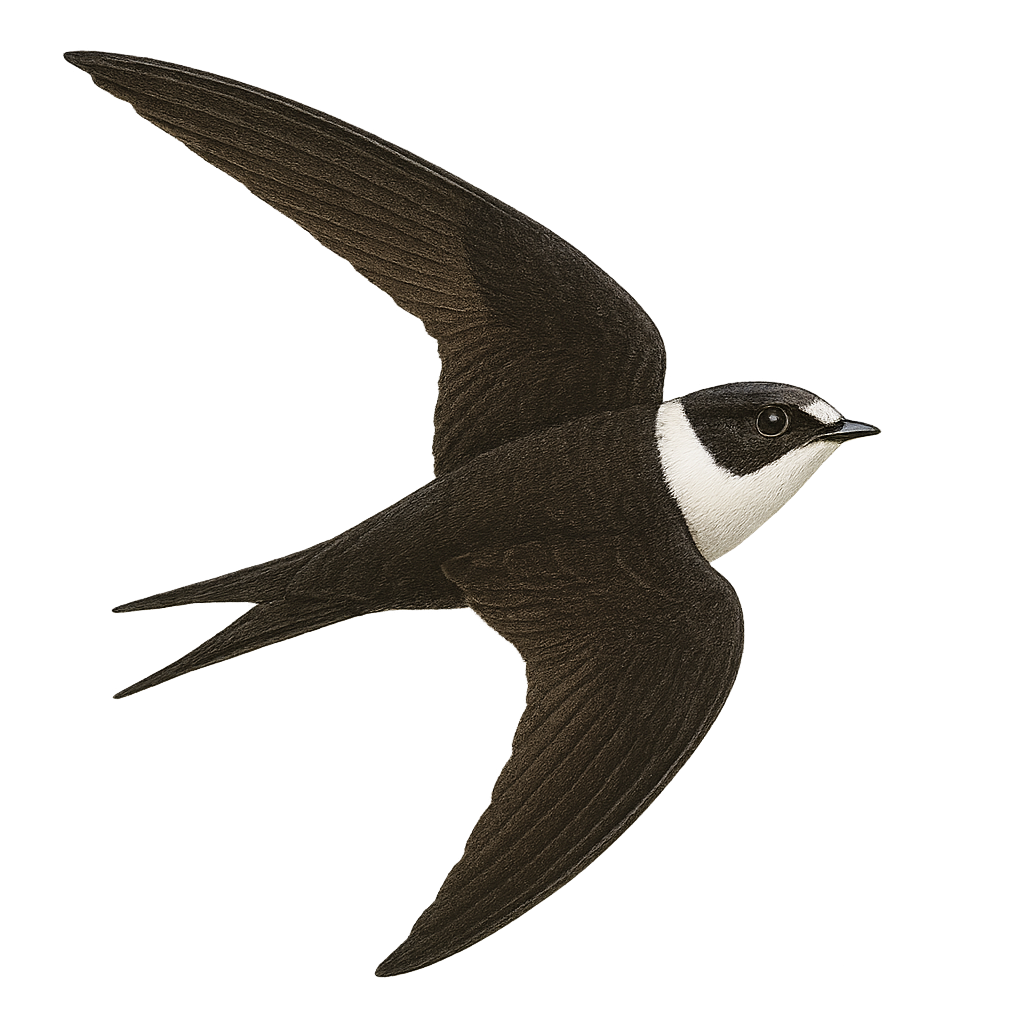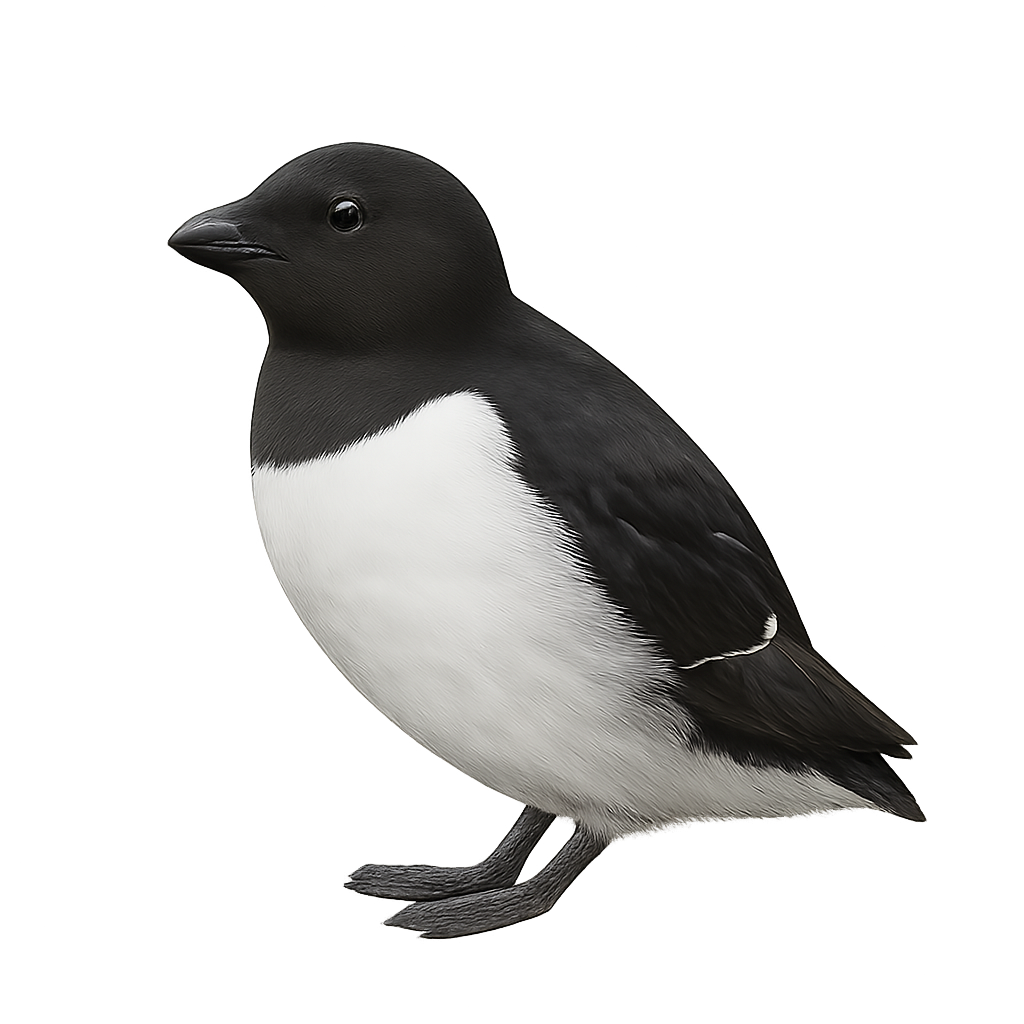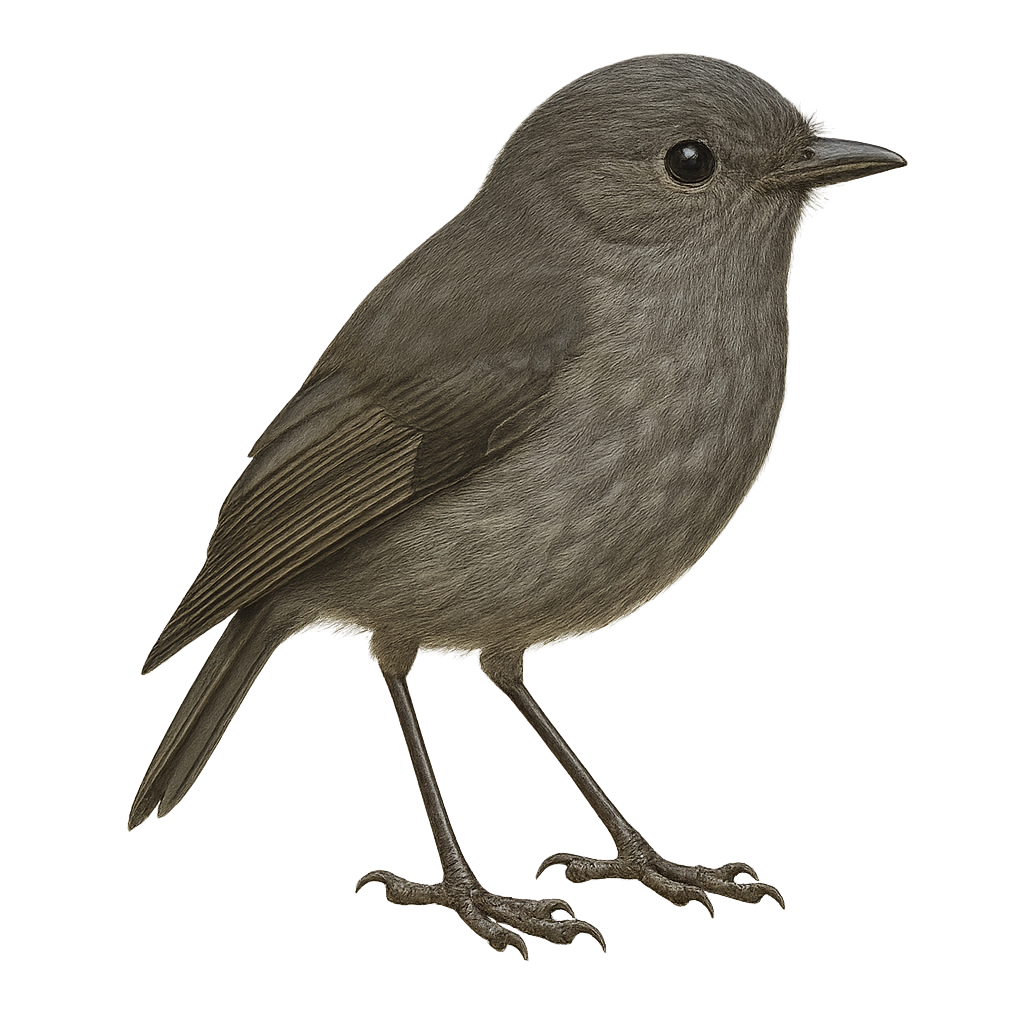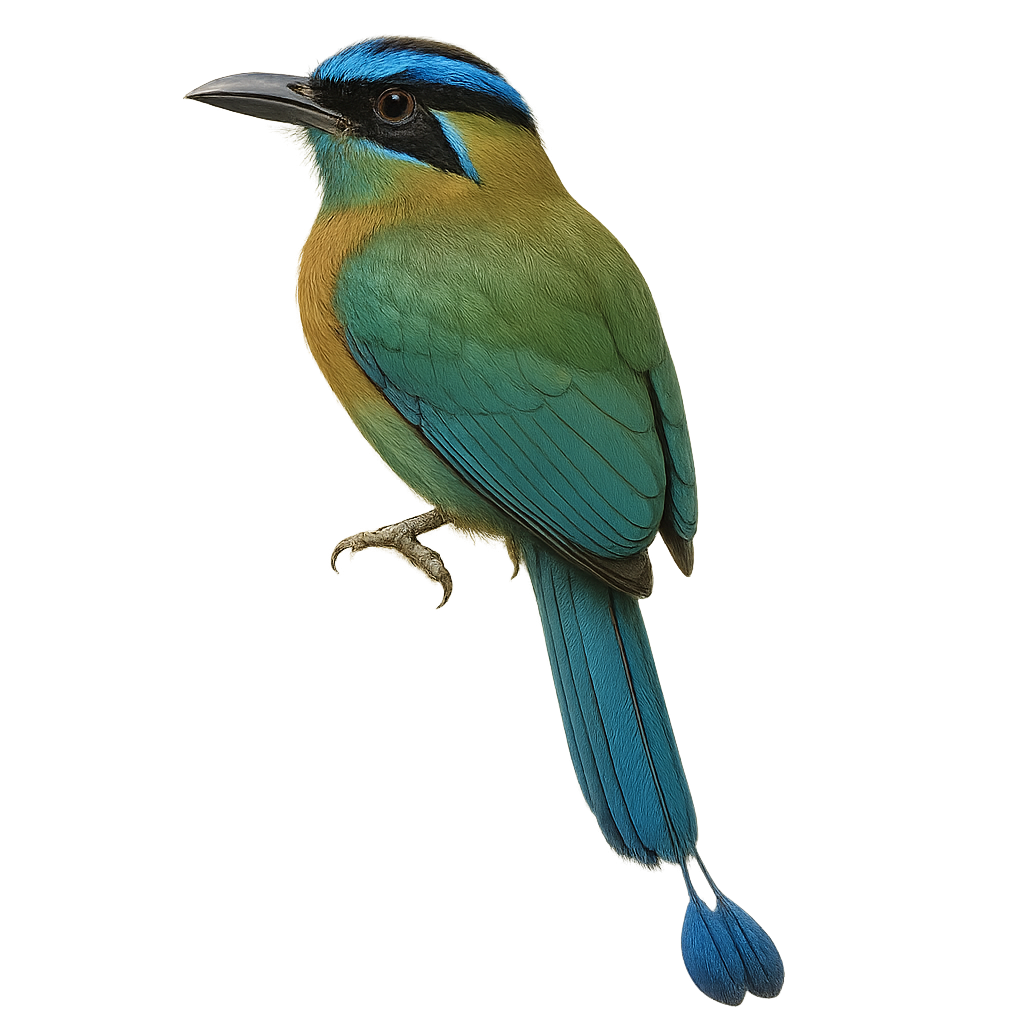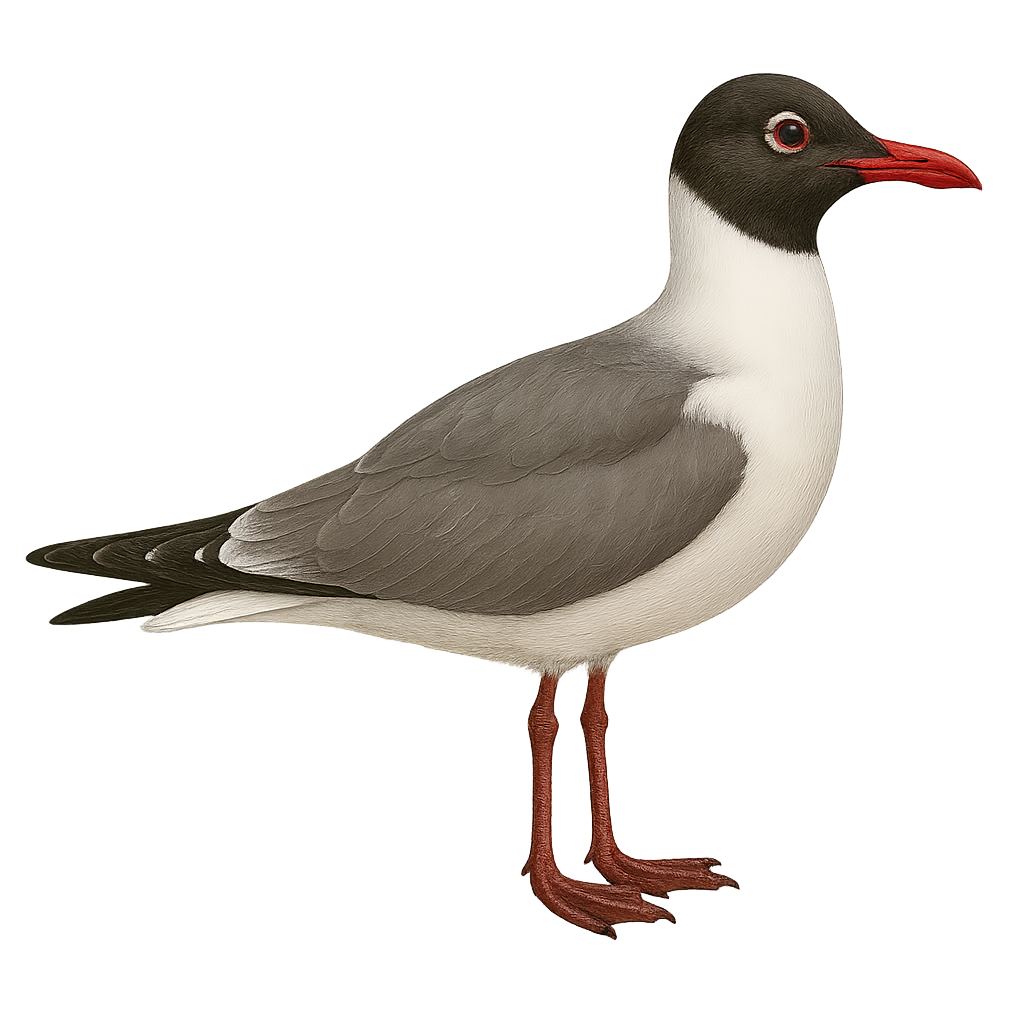The Large Elaenia is a bird from the Tyrannidae family, identifiable by its medium size and primarily olive-green plumage with lighter shades on the belly. Its short, robust beak is suited for its mainly insectivorous diet, although it also consumes fruits. It is primarily found in tropical and subtropical forests but also adapts to open wooded areas. Its song is a melodious trill, often heard at dawn. This bird is migratory, moving with the seasons to find food resources. It is generally solitary or seen in small family groups.
The Lesser Nighthawk, Chordeiles acutipennis, is a nocturnal bird belonging to the Caprimulgidae family. It is primarily found in arid and semi-arid regions of the Americas, from the southern United States to Argentina. This bird is recognizable by its cryptic brown-gray plumage, which allows it to blend into its surroundings, and its long pointed wings. It feeds mainly on insects caught in flight with its wide mouth. During the breeding season, the male performs aerial displays to attract a mate. Nests are often simple ground depressions where the female typically lays two eggs. The species is considered of least concern by the IUCN, although some populations may be affected by habitat loss.
The Long-tailed Hermit, or Phaethornis superciliosus, is a fascinating hummingbird found mainly in the tropical forests of South America. This small bird is recognizable by its long, curved bill, perfect for extracting nectar from tubular flowers. Its plumage is primarily brown with greenish hues and a distinctive stripe above the eye, giving it the name "superciliosus". It is often seen darting from flower to flower, playing a crucial role in pollination. Although generally solitary, it can sometimes be observed in small groups during the breeding season. Its ability to adapt to various habitats, including forest edges and gardens, makes it a resilient bird despite environmental threats.
The Lady Amherst's Pheasant is a striking bird known for its vibrant plumage and long tail feathers. Native to the mountainous forests of China and Myanmar, it was introduced to Europe in the 19th century. The male boasts colorful plumage with intricate patterns of green, red, blue, and white, while the female is more subdued with brown tones. These birds prefer dense forest habitats where they feed on seeds, fruits, and insects. Although primarily terrestrial, they can fly short distances to evade predators. Their behavior is generally suspicious, making them challenging to observe in the wild.
The Lesser Kestrel, or Falco naumanni, is a small diurnal raptor belonging to the Falconidae family. It is distinguished by its modest size, measuring about 30 to 35 cm in length with a wingspan of 60 to 75 cm. Its plumage is characteristic: the male has a rufous back without spots, a grey-blue head, and wings with black tips, while the female displays a duller and more speckled plumage. This falcon primarily feeds on insects but can also hunt small mammals and reptiles. It inhabits open areas such as grasslands, steppes, and agricultural zones. A migratory bird, it breeds in Europe and Central Asia and winters in sub-Saharan Africa. Its population is declining mainly due to habitat loss and pesticide use.
The Red-footed Falcon is a small raptor, particularly recognizable by its delicate plumage and vivid colors. It measures about 30 to 35 cm in length, with a wingspan of 70 to 80 cm, and weighs between 150 and 200 g. The adult male has a distinctive blue-gray plumage, with pointed wings and a lighter head, while the female is browner and slightly larger. The Red-footed Falcon primarily inhabits open areas such as meadows, agricultural fields, and steppes in Eastern Europe, Asia, and North Africa. It primarily preys on insects, small birds, and sometimes reptiles. This falcon is known for its ability to catch prey in flight, performing fast and precise maneuvers. It is particularly active at dusk and in the evening, hence its name "Red-footed" (referring to its late-day hunting). Although the species is not yet endangered, it is threatened by habitat loss and the decline of its prey populations.
The Lanner falcon, Falco biarmicus, is a medium-sized raptor known for its brown-gray plumage with white and rufous tones. It has long, pointed wings and a relatively long tail. This agile predator is often seen in fast flight, primarily hunting birds in open air. It inhabits open regions such as savannas, steppes, and semi-deserts. Its range extends across Africa, southern Europe, and parts of Asia. The Lanner falcon is a social bird, often seen in small groups or pairs. Although a formidable hunter, it is also vulnerable to human disturbances and habitat loss.
The Lesser Flamingo, Phoeniconaias minor, is a graceful and slender bird, primarily found in the alkaline lakes of East Africa and some regions of India. It is distinguished by its pale pink plumage, long and thin legs, and a dark red, curved beak. This flamingo is the smallest of its kind, standing about 80 to 90 cm tall. It lives in large colonies, often consisting of thousands of individuals, which helps protect it from predators. Its diet mainly consists of blue-green algae and small crustaceans, which it filters with its specialized beak. The Lesser Flamingo is a migratory bird, moving according to seasonal water level changes.
The Lesser Frigatebird is a striking seabird known for its sleek silhouette and long, scythe-shaped wings. It is primarily black with a white belly in males, while females have a white breast band. This bird is renowned for its graceful flight and ability to soar long distances effortlessly. Lesser Frigatebirds feed mainly on fish and squid, which they catch at the water's surface. They are also known for their kleptoparasitic behavior, stealing food from other seabirds. They nest in colonies on tropical islands, building rudimentary nests in trees or shrubs.
The Lesser Scaup, Aythya affinis, is a medium-sized diving duck known for its rounded head and grayish plumage. Males have a black head with purple sheen, gray back, and white belly, while females are duller with a brown head and a white ring around the bill. They primarily feed on mollusks, crustaceans, and aquatic plants. Their preferred habitats include lakes and ponds in North America, where they migrate in large flocks. Their flight is fast and direct, often in tight formation. Although common, their population is monitored due to environmental changes.
The Large Niltava is a bird from the Muscicapidae family, known for its vibrant plumage and melodious songs. This bird is primarily found in the humid forests of the Himalayas and Southeast Asia. The male sports bright blue plumage with black accents, while the female has more subdued shades of brown and orange. The Large Niltava is a territorial bird that feeds mainly on insects and small fruits. It is often seen alone or in pairs, moving nimbly among dense branches. Although its habitat is threatened by deforestation, it remains relatively common in protected areas.
The Little Grebe is the smallest European grebe, measuring about 29 cm in length with a wingspan of 40 to 45 cm. In breeding plumage, it has a bright chestnut throat and nape, giving it its name, and a yellow spot at the base of the bill. In non-breeding plumage, it is more subdued, with a dark brown back and a light belly. It inhabits wetlands such as lakes, ponds, marshes, and reed beds, where it can easily hide. It feeds primarily on aquatic insects, small crustaceans, tadpoles, and small fish. Reproduction occurs from March to July, with one or two clutches of 4 to 7 eggs each. The young are precocial and can swim and dive immediately after hatching. A partial migrant, it winters in the milder regions of Europe. Listed as Least Concern by the IUCN.
The Least Grebe, or Tachybaptus dominicus, is a small waterbird belonging to the family Podicipedidae. It is the smallest grebe, measuring about 21 to 27 cm in length with a wingspan of 40 cm. Its plumage is generally dark gray above and paler below, with a brownish tint on the flanks. It has a short, pointed, often black bill. This grebe is primarily found in freshwater habitats such as ponds, marshes, and lakes with dense vegetation. It is an excellent diver, feeding mainly on small fish, aquatic insects, and crustaceans. Its range extends from the United States to northern South America.
The Long-tailed Tapaculo, or Drymophila caudata, is a captivating bird found in the humid forests of South America, particularly in the Andes. This medium-sized bird, measuring about 18 cm in length, is notable for its long, slender tail and reddish-brown plumage, adorned with subtle patterns that help it blend into its surroundings. It is often heard before seen, thanks to its distinctive and melodious song. The Long-tailed Tapaculo is a shy bird, preferring dense undergrowth where it primarily feeds on insects and other small invertebrates. Despite its reclusive nature, it plays a crucial role in the forest ecosystem by controlling insect populations.
The Little Bee-eater, Merops pusillus, is a vibrant and fascinating bird, easily recognizable by its bright green plumage, yellow throat, and distinctive black eye stripe. Measuring about 15 to 17 cm in length, it is one of the smallest members of its family. It primarily inhabits savannas, open woodlands, and riverine areas in sub-Saharan Africa. The Little Bee-eater is an agile predator, feeding mainly on flying insects, especially bees and wasps, which it catches in flight. It is often seen in small groups, perched on low branches, from where it launches to catch its prey. Although relatively tolerant of human presence, it remains cautious and prefers to keep its distance.
The Common Eider is a medium-sized seabird, easily recognizable by its distinctive plumage and diving behavior. It measures about 40 cm in length, with a wingspan of 65 to 75 cm, and weighs between 500 and 900 g. Its plumage is primarily black and white, with a black head, a wide white band around the neck, and white spots on the wings. The male, during the breeding season, has a bright orange beak and a distinctive white line running from the beak to the back of the head. The Common Eider primarily inhabits the cold waters of the North Atlantic, notably around the coasts of Iceland, Greenland, Canada, and Northern Europe. It is an excellent diver, feeding mainly on small fish, crustaceans, and marine invertebrates, which it captures underwater. The Common Eider migrates southward during the winter. Although the species is not currently endangered, it is vulnerable to marine pollution, climate change, and disturbance of its breeding sites.
The Long-eared Owl is a medium-sized nocturnal raptor, easily recognizable by its large tufts of feathers shaped like "ears" on its head. It measures about 35 to 40 cm in length, with a wingspan of 85 to 100 cm, and weighs between 250 and 400 g. Its plumage is generally gray or brown with dark banded patterns, allowing it to blend perfectly in wooded and open forest areas. It has large yellow eyes and a disc-shaped face, like other owls, which helps it capture sound in the dark. The Long-eared Owl primarily inhabits forests, woodlands, and heathlands across Europe, Asia, and North Africa, where it primarily feeds on small mammals, such as voles, mice, and occasionally birds. It generally hunts at dusk, using its sharp vision and keen hearing to detect its prey. While the species is not endangered, it is vulnerable to deforestation and habitat loss.
The Long-tailed Jaeger is an elegant and agile seabird, known for its distinctive long tail and slender wings. It is the smallest of the jaegers, measuring about 50 cm in length with a wingspan of 100 to 110 cm. Its plumage varies with the season, turning from dark brown in winter to lighter gray in summer, with white shades on the belly. This jaeger is a remarkable migrator, traveling long distances between its breeding grounds in the Arctic and its wintering areas in the southern hemisphere. It primarily feeds on fish and marine invertebrates but does not hesitate to harass other birds to steal their food.
The Lanceolated Warbler is a small, elusive bird belonging to the Locustellidae family. It is characterized by its brownish plumage, finely streaked with black, which allows it to blend into its natural habitat. This bird prefers wetlands, meadows, and marshes, where it primarily feeds on insects and small invertebrates. Its song is a rapid, monotonous trill, often heard at dusk. The Lanceolated Warbler is migratory, spending its summers in Eurasia and winters in Southeast Asia. Although its conservation status is currently "least concern," it is threatened by habitat destruction due to intensive agriculture and wetland drainage.
The Little Blue Penguin, also known as the Fairy Penguin, is the smallest of the penguin species, measuring about 30 to 40 cm in height and weighing between 1 and 1.5 kg. It has a distinctive blue-gray plumage on its back and wings, with a white belly. Its beak is short and dark, and its feet are pink or gray. The Little Blue Penguin primarily lives along the coasts of New Zealand and Australia, inhabiting colonies on beaches, islands, and cliffs. Unlike other penguins, the Little Blue Penguin is capable of swimming at impressive speeds, allowing it to hunt fish, crustaceans, and squid underwater. Although it is an excellent swimmer, it also spends time on land, where it digs burrows or hides in shrubs to protect itself from predators. While its population remains relatively stable, it faces threats such as climate change, predation by introduced animals, and habitat disruption.
The lesser adjutant (Leptoptilos javanicus) is a large stork standing 110–120 cm tall with a 210 cm wingspan, exhibiting black upperparts and wings contrasted by a white belly and tail-underparts, and a bare pale gray head and neck. It inhabits coastal and inland wetlands of Southeast Asia, including mangroves, estuaries, flooded rice fields, and riparian forests. Feeding on amphibians, large invertebrates, and carrion, it forages by wading and probing with its long bill. Colonial breeder, it performs bill-clattering and neck-arching displays during nesting (February 1–May 31). Pairs lay 2–4 eggs, incubated 28–30 days, with chicks hatching March 1–June 30.
The Little Kingfisher, or Ceyx pusillus, is a small, colorful bird found in the tropical forests of Southeast Asia. Known for its vibrant plumage, it features shades of blue, orange, and white. Measuring about 12 cm in length, it is one of the smallest kingfishers. This tiny bird primarily feeds on insects and small fish, which it catches by swiftly diving into the water. It prefers habitats near streams, where it can easily find food. Despite its size, it is an agile and precise hunter. The Little Kingfisher is often difficult to spot due to its discreet nature and dense habitat.
The Lesser Swallow-tailed Swift, or Panyptila cayennensis, is a fascinating bird primarily inhabiting the tropical regions of Central and South America. This small bird, about 14 cm long, is easily recognizable by its forked tail and black and white plumage. It is often observed in fast and graceful flight, capturing insects in mid-air. Its natural habitat includes tropical forests, forest edges, and sometimes urban areas. Although it is often on the move, it nests in tree cavities or artificial structures. The Lesser Swallow-tailed Swift is a social bird, often seen in groups, and its ability to fly at high speeds allows it to easily escape predators.
The Little Auk is the smallest of the Atlantic alcids, measuring about 19 to 21 cm in length with a wingspan of 34 to 38 cm. Its plumage is black on the back and head, with a white face and belly. It has a short, stout bill adapted for catching small marine prey. A gregarious species, it forms massive breeding colonies on Arctic rocky coasts, nesting in crevices or under boulders. Outside the breeding season, it lives in the open sea, often near pack ice. It feeds mainly on copepods, krill, and small fish, which it captures by diving. Although currently listed as Least Concern, climate change and ocean pollution pose potential threats to its habitats.
The long-tailed tit is a small passerine bird distinguished by its very long tail, nearly as long as its body. It is primarily found in mixed forests, hedgerows, and wooded parks across Europe and Asia. This small bird is often seen in groups, moving quickly from tree to tree in search of insects and spiders, which it catches with agility. Its tail helps it maintain perfect balance when perched and allows it to navigate through branches to forage.
The Petroica longipes, commonly known as the Long-legged Flyrobin, is a small bird from the Petroicidae family. It is endemic to New Zealand, primarily inhabiting dense forests and wooded areas. This passerine is distinguished by its black and white plumage, with a striking white breast and relatively long legs that give it an elegant appearance. The Long-legged Flyrobin is an insectivore, feeding mainly on small insects and spiders caught on the ground or low branches. It is known for its melodious song and elaborate courtship displays. Although its habitat is limited, it is not currently considered threatened.
The Lesson's Motmot is a colorful and fascinating bird native to the humid tropical forests of Central America. It is distinguished by its vibrant plumage, which combines shades of blue, green, and orange, and its long, racket-shaped tail. This bird measures about 38 to 48 cm in length and weighs between 100 and 160 grams. It is often seen perched quietly on a branch, scanning its surroundings for insects and small reptiles, which make up the bulk of its diet. The Lesson's Motmot is also known for its melodious and repetitive song that echoes through the canopy.
The LeConte's Thrasher is a discreet and little-known bird, endemic to the arid regions of the southwestern United States and northwestern Mexico. It is distinguished by its gray-brown plumage, long curved bill, and elongated tail. Adapted to desert environments, it primarily feeds on insects and small invertebrates that it finds in the sandy soil. Its melodious and varied song is often heard at dawn. The LeConte's Thrasher is monogamous and builds its nest in thorny bushes to protect itself from predators. Although its habitat is threatened by human expansion, it is still relatively common in some remote areas.
The Least Flycatcher is a small passerine bird belonging to the Tyrannidae family, known for its distinctive "chebec" call. It inhabits deciduous forests and wooded areas across North America. With its olive-gray plumage, white belly, and two white wing bars, it is easily recognizable. This migratory bird primarily feeds on insects, which it catches in flight. Often seen perched, it watches for prey with keen eyes. Despite its small size, the Least Flycatcher plays a crucial role in forest ecosystems by helping control insect populations.
The Laughing Gull, Leucophaeus atricilla, is a medium-sized bird known for its distinctive plumage and characteristic call. During the breeding season, it sports a black head, gray back, and wings with black tips. The rest of its body is white, and its bright red bill contrasts with its plumage. Outside the breeding season, its head turns white with gray spots. It primarily inhabits coasts and islands, feeding on fish, crustaceans, and waste. Sociable by nature, it often gathers in large colonies. Its adaptability to urban environments makes it a common sight along the Atlantic coasts and the Gulf of Mexico.


